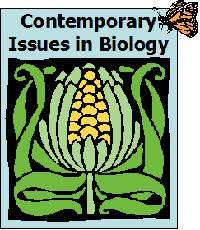
Week 7, Chapter 13 -- Digging Deeper Sample Answer
Course home | Weekly schedule | Announcements | Instructor Info | Desire2Learn | MasteringBiology® | Honor Code | FAQs | HELP!
 |
Week 7, Chapter 13 -- Digging Deeper Sample AnswerCourse home | Weekly schedule | Announcements | Instructor Info | Desire2Learn | MasteringBiology® | Honor Code | FAQs | HELP! |
[Note that I have used press releases, not the types of news items that I expect you to use for this assignment.]
Article 1 Summary: The first article I chose was this one: http://archive.americanfarm.com/TopStory11.16.04c.html
Three different agricultural leaders comment on the recent discovery of a disease called soybean rust in the United States. Since most of the year’s soybeans have already been harvested, the disease is currently not a problem, but farmers are concerned that the cost of controlling the disease will increase the cost of soybeans in future years.
Connection: The connection to the human population is a bit indirect. To feed the most possible people at the lowest possible cost, farmers plant huge acreages of genetically uniform crops. When many farmers plant the same variety of crops, one disease can ravage the entire yield. To protect their crop yields from disease-causing organisms, farmers must use pesticides. These chemicals kill nontarget organisms, migrate into the water and into the food chain, and possibly cause health problems in humans. These are the consequences of a cheap, reliable, continuous supply of food for the world’s population.
Personal reflection: I have a degree in plant pathology (diseases of plants), so I am interested in stories about how diseases spread among plants. This one particularly interested me because rust fungi have interesting and complex life cycles. The story also makes me wish that more farmers would use sustainable practices to raise their crops, but such practices increase costs to the grower, so they are not extensively used.
AmericanFarm.com. 2004. Soybean rust: Not if, but when. Accessed at http://archive.americanfarm.com/TopStory11.16.04c.html on 1/2/15.
Article 2 Summary: The second article I chose was this one:
http://www.greenpeace.org/usa/en/media-center/news-releases/twenty-one-percent-of-women-te/
It is a statement from Greenpeace about a study on mercury poisoning. The study found that 21% of women of childbearing age had more than the EPA’s limit of mercury in their hair. The press release says that most of the mercury people encounter is from coal-fired power plants. The emissions fall into water bodies, where the mercury concentrates in fish. The more fish a person eats, the more mercury is in the person’s body.
Connection: The connection to the human population is two-fold. First, a large proportion of the world’s population depends on fish as a source of protein. As the human population grows, more people will be exposed to the mercury and potential health problems. Second, a growing population means greater demand for energy. As high quality fuels such as oil become scarcer, energy suppliers will turn to cheaper, lower quality fuels such as coal. Thus, we can expect more mercury exposure as the human population grows.
Personal reflection: Articles like this make me want to do as much as I can to conserve energy. And although I’m sure not everyone agrees with me, I would be willing to pay more for energy if I knew that mercury and other pollutants were being “scrubbed” out of the emissions.
Greenpeace. 2004. Twenty-one percent of women tested nationwide have mercury levels higher than EPA limit. Accessed at http://www.greenpeace.org/usa/en/media-center/news-releases/twenty-one-percent-of-women-te/ on 1/2/15.
[461 words]
[Back to Digging Deeper assignment]
[Sample assignment by Mariëlle Hoefnagels and Mark Walvoord]